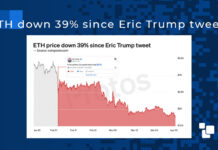Even if Coinbase goes bankrupt, the underlying Bitcoin of spot Bitcoin ETFs will not be commingled, 21Shares and 21.co co-founder Ophelia Snyder says.
As 10 asset managers in the United States have started trading billions in spot Bitcoin exchange-traded funds (ETFs), investors might wonder how these issuers ensure that the underlying asset of their products is safe enough.
Despite cryptocurrency exchanges losing comparatively less money to hacks over the past few years with new security improvements, the community witnessed multimillion-dollar attacks on exchanges like Poloniex in 2023. Is there anything that makes a spot Bitcoin ETF safer than trading on an exchange like Poloniex as a retail user?
Bitcoin custody products used by spot Bitcoin ETF providers are “nothing like what retail gets access to” on crypto exchanges, according to Ophelia Snyder, co-founder of 21Shares and its parent firm, 21.co.
“We’re using Coinbase as a custodian for a U.S. product. Me putting money on Coinbase as Ophelia Snyder and me putting money on Coinbase as 21Shares, the products are structurally different,” the executive said in an interview with Cointelegraph in early January.
21Shares is one of the firms involved in the issuance of now-running spot Bitcoin ETFs in the United States, cooperating with ARK Invest on the ARK Invest and 21Shares spot Bitcoin ETF (ARKB). Based in Europe, 21.co and 21Shares also operate a wide number of crypto exchange-traded products (ETPs) in the region and are one of the largest crypto ETP providers globally.
When someone puts assets on an exchange as a retail user, trading platforms like Coinbase often put client assets on omnibus accounts, where user assets like Bitcoin are pooled together without strict segregation. “It’s there with everybody else’s money,” Snyder noted, referring to such exchange accounts, adding that the spot Bitcoin ETFs by ARK and 21Shares uses strictly segregated accounts. She stated:
“Our money goes into a specific wallet that belongs to us. In our case, actually multiple wallets, because we don’t want to have a single attack surface. That way, we actually split across multiple wallets.”
Snyder mentioned that for its European products, 21Shares also diversified across custodians in order to provide better security.
A spot Bitcoin ETF is also “a lot safer from a bankruptcy perspective,” according to Snyder. “If everybody at 21Shares disappears tomorrow, there’s a mechanism using a trustee to allow for the recovery of those assets directly from Coinbase,” the executive said. And even if Coinbase goes bankrupt, there’s still a way not to have those assets commingled, Snyder added.
To add another layer of security for its Bitcoin ETF, 21Shares also uses multiple authorization steps. “There’s no single individual that can actually move these assets within the organization,” Snyder stated. She said that such a level of security is reached by splitting the private key into multiple pieces and holding those parts in geographically distributed vaults.
21Shares has been battle testing its implementation with custodians for five years, Snyder said in a session of X Spaces (formerly Twitter Spaces) on Jan. 10. “You can’t treat this like any other asset in the world,” the executive stressed, adding that Bitcoin ETF providers have to hold their Bitcoin offline in wallets that have never been brought into the internet.
The long-awaited approval of the first spot Bitcoin ETF in the U.S. took place on Jan. 10, 2024, with the first BTC ETFs starting trading the next day. At launch, eight out of 10 spot Bitcoin ETF providers relied on Coinbase custody as institutions, with some issuers like Fidelity Investments opted for their proprietary custody solution, Fidelity Digital Asset Services.
Another Bitcoin ETF issuer, VanEck preferred to custody the underlying BTC with Gemini, a crypto trading platform Cameron and Tyler Winklevoss co-founded. As previously reported, the Winklevoss twins were the first-ever applicants for a spot Bitcoin ETF with the U.S. Securities and Exchange Commission back in July 2013.
Source: cointelegraph.com




